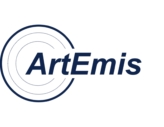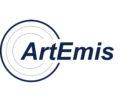Awareness and resilience
through European multi sensor system
A Euratom H2022 research project
Awareness and resilience through European multi sensor system

Danciu L., Nandan S., Reyes C., Basili R., Weatherill G., Beauval C., Rovida A., Vilanova S., Sesetyan K., Bard P-Y., Cotton F., Wiemer S., Giardini D. (2021). The 2020 update of the European Seismic Hazard Model: Model Overview. EFEHR Technical Report 001, v1.0.0, https://doi.org/10.
rtEmis will design, build, and operate a smart and scalable multi sensor system comprising of about 100-200 novel low-cost geochemical sensors, that will measure with unprecedent spatial and temporal resolution changes in radon concentration in ground water, together with other observables like temperature and acidity.
Scientific Background
Artemis will place over 100 sensors for radon detection and measurements along fault zones in earthquake prone areas in Greece and Italy, and a minor set along the Swiss Alps. Radon emission and variations in concentration has since long been proposed and used as an earthquake precursor. One will find over 600 publications when searching for radon as an earthquake precursor. There are several problems associated with radon measurements published in the literature: a large set of measurements have been performed in air or soil, that carry substantial uncertainties due to large variations of the natural background. Other reports rely on rather large distances between measurements sites and the epicenter, uncertain time window etc.
The present project will shed light on many issues related to radon measurements and analysis, by (i) measuring radon with a high spatial resolution due to the large number of sensors, (ii) measurements in groundwater in real time, and (iii) by deploying advanced data analysis via machine learning algorithms.
ArtEmis’ ultimate aim is to improve earthquake forecasting. While it is possible to forecast earthquakes in specific regions (e.g. an earthquake of a certain magnitude will occur in the next 50 years at a certain location with a certain probability), with present knowledge, predictions of earthquakes (i.e. when and where exactly an earthquake is going to occur) are not possible. However, using the definition accepted in literature by Max Wyss* (see below), requiring accurate information about the location within a certain radius, estimation of the magnitude and a time window when an earthquake will occur, we will be able to test our precursor signals against short-term predictions of earthquakes.
An important aim of artEmis is to provide new/novel knowledge about the quantitative relation of various proxies that can act as precursors, that are to be measured in groundwater, and to correlate these data to subsequent earthquakes. Since the likelihood of a large earthquake during the duration of the project is not very high, information gathered on the relation of potential precursors to seismic activity will be somewhat limited. Hence, one needs to realize that artEmis will require continuation and if possible, expansion for further advancement of our knowledge. Provided the artEmis sensor system is working well, members of artEmis will engage to find financial support for the continuation and expansion of the network, as outlined in the communication and dissemination strategy.
Scientific results
PUBLIC DELIVERABLES
Crowley H., Dabbeek J., Despotaki V., Rodrigues D., Martins L., Silva V., Romão X., Pereira N., Weatherill G., Danciu L. (2021). European Seismic Risk Model (ESRM20), EFEHR Technical Report 002, V1.0.0, 84 pp, https://doi.org/10.7414/
WORK PACKAGES
News and Events
!! REGISTRATION OPEN !!!
ARTEMIS Stakeholder and Science Workshops
June 17-19th, 2024
IESE Business School, University of Navarra, Barcelona, Spain
Partners

Newsletter
Contacts
Project Coordinator: Ayse Atac Nyberg, KTH
email: ayseatac@kth.se
Page updated on May 20th, 2024

